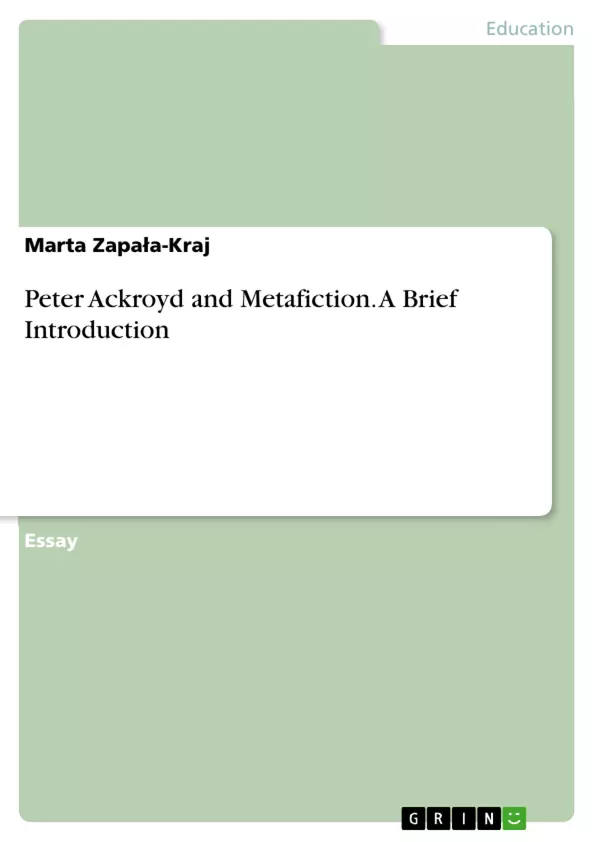Peter Ackroyd was born in London in 1949 and educated at St. Benedict’s School, Ealing. He graduated from Clare College, Cambridge and then won a research fellowship to study at Yale University from 1971-73. He was awarded the Whitbread Prize and the Guardian Fiction Prize. Described as one of the most original 1980s British writers, Ackroyd was compared with novelists such as Salman Rushdie or Jeanette Winterson. Modestly, Ackroyd considers his output, which includes poetry, biographies, and novels simply as ‘writing’, being the result of the simple creative impulse.
"One can [...] assume that unlike any piece of fiction, metafiction is fiction about fiction, i.e. fiction which self-consciously reflects upon its own nature, its modes of production, and its intended effect on the reader."
Inhaltsverzeichnis (Table of Contents)
- Peter Ackroyd and Metafiction
- Defining ‘metafiction’
- Historiographic Metafiction
- Tragic Hero.....
- Last Testament of Oscar Wilde as Metafictious Novel
- Wilde as Conscious Narrator.......
Zielsetzung und Themenschwerpunkte (Objectives and Key Themes)
This work explores the concept of metafiction, particularly as it relates to the writing of Peter Ackroyd. The text examines the definition of metafiction, its historical context, and its manifestation in Ackroyd's work, particularly within the context of his novel *The Last Testament of Oscar Wilde*. Key themes explored in the text include:- The nature and evolution of metafiction
- The relationship between fiction and reality
- The role of the author and the reader in the creation of meaning
- The use of self-reflexive devices in literature
- The influence of postmodernism on literary form and content
Zusammenfassung der Kapitel (Chapter Summaries)
- **Chapter 1: Peter Ackroyd and Metafiction** introduces Peter Ackroyd as a writer and explores his unique approach to metafiction. It discusses his career and his contributions to literature, drawing attention to the shift in his style and the possible reasons behind it.
- **Chapter 2: Defining ‘metafiction’** explores the concept of metafiction. It examines different critical perspectives on the term, citing various authors and their works to illustrate key concepts and definitions.
- **Chapter 3: Historiographic Metafiction** delves into the specific subgenre of historiographic metafiction, highlighting its complexities and its relationship to postmodernism.
- **Chapter 4: Tragic Hero.....** This chapter provides a deeper examination of Ackroyd's work and how it engages with the elements of tragic heroism in a metafictional context.
- **Chapter 5: Last Testament of Oscar Wilde as Metafictious Novel** focuses on Ackroyd's novel *The Last Testament of Oscar Wilde* as an example of metafiction. It analyzes how Ackroyd utilizes metafictional techniques within the novel to create a unique narrative experience.
- **Chapter 6: Wilde as Conscious Narrator.......** This chapter continues to explore the novel *The Last Testament of Oscar Wilde*, concentrating on how Wilde's role as a conscious narrator influences the text and its themes.
Schlüsselwörter (Keywords)
The key terms and concepts addressed in this work include metafiction, historiographic metafiction, postmodernism, self-reflexivity, fictionality, authorial intent, reader response, and the works of Peter Ackroyd and Oscar Wilde.- Quote paper
- MA Marta Zapała-Kraj (Author), 2015, Peter Ackroyd and Metafiction. A Brief Introduction, Munich, GRIN Verlag, https://www.grin.com/document/288354



